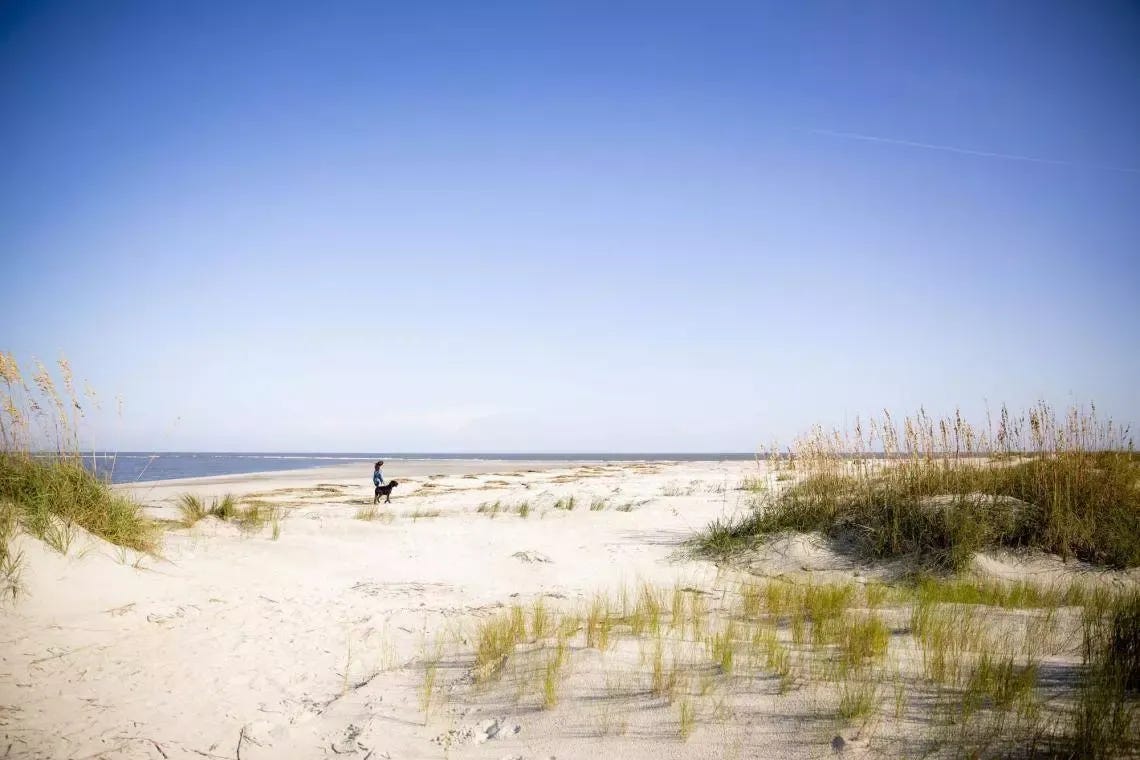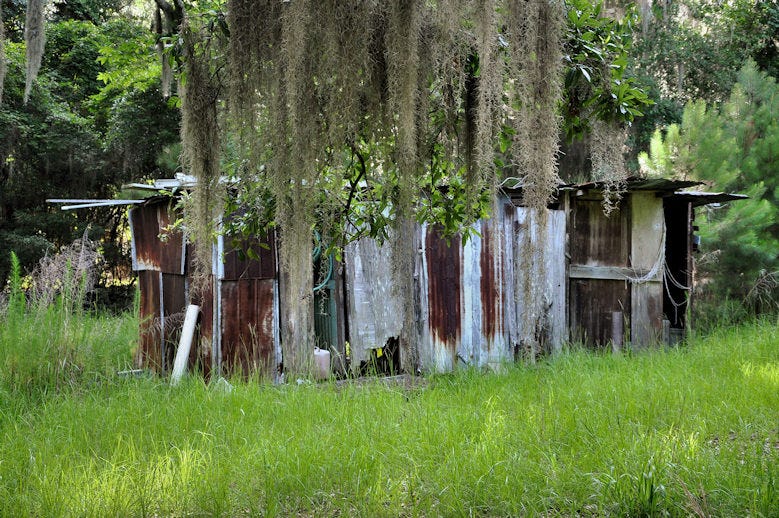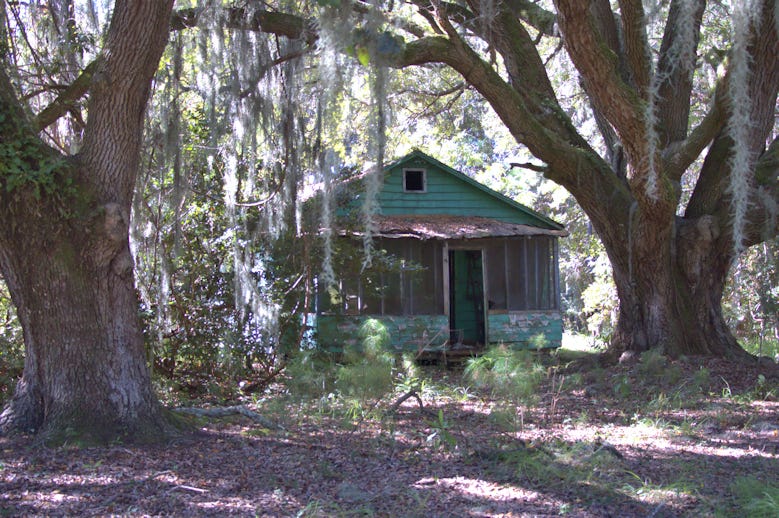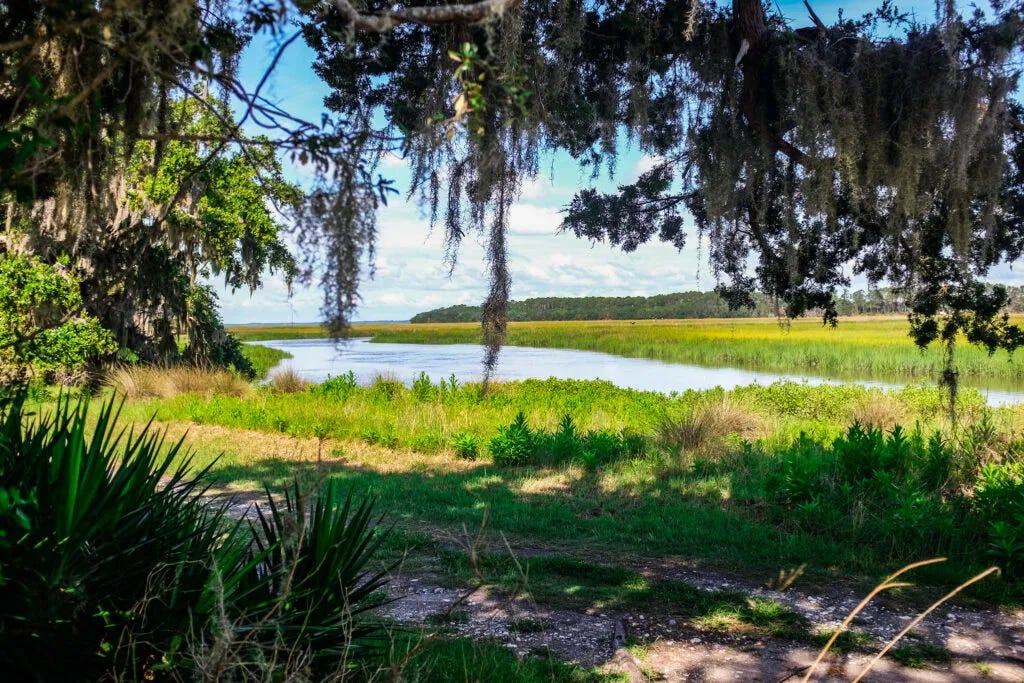The Vanishing South
At this time the Gullah-Geechees of Sapelo Island are endangered.
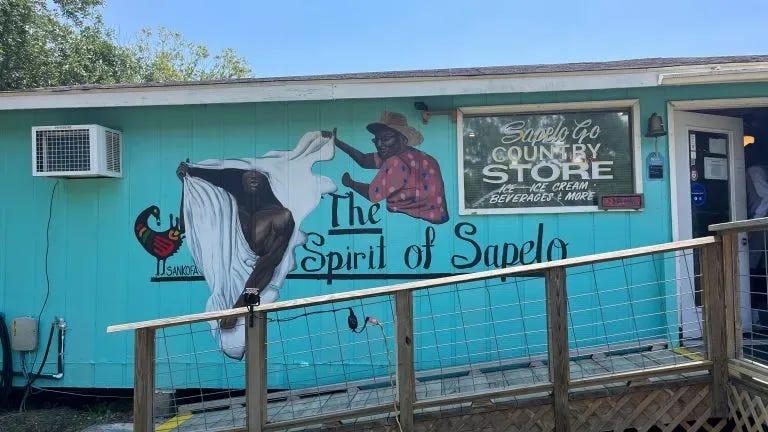
Gradually, the boat starts to pull away from the mainland in Meridian, Georgia as the thunderous roar of the engines start up. We could be in the year 2025 or 1910. Not much has changed here. Situated about sixty miles south of Savannah, we are headed to Sapelo Island in the center of coastal Georgia’s well-defined chain of barrier islands. I stood on the bow and watched the miles of deep green marsh grass fade into the distance.
My friend Sandra Roper, a popular Charleston artist, has arranged for her friend, Caleb, to meet us at the dock with his golf cart and a tour of the island. He is a steward of the island’s deep-rooted Gullah Geechee culture. He owns a home here and shoulders a burden of history, fighting against powerful forces to ensure that families who live in Hog Hammock, now a shrinking community of about 30 within the island, might remain in the place of their ancestors far into the future. Their hopes and dreams have become increasingly daunting. We are here to learn more about what is happening to them and their unique three-hundred-year-old African American culture.

Its champion was Cornelia Walker Bailey who passed away in 2017. Others must now take up her mantel to preserve Hog Hammock’s distinctive history. Dirt roads led us past wild pigs and cows that roamed freely. Vegetation was dense with medicinal plants and patches of heirloom Sapelo red peas were scattered in backyards along the way reflecting Sapelo’s past. Caleb spoke of the Gullah Geeechee’s use of these medicinal herbs. Pointing to a sun-loving plant, he said, “This grows all over the island and folks call it life everlasting. Most Southerners know it as “rabbit tobacco.”I had never heard of it. “This wild plant has been used for centuries in the Lowcountry to treat wounds, freshen the air in homes, and make a strong tea that gives one a longer life, he explained.” He also noted that it was used to ward off evil spirits.
The shoreline is lined with miles of white sandy beach and acres of dunes. Open water gives way to pluff mud and spartina grass that rises 7 feet tall in the marshlands. The transition to higher ground includes elevated small islands called hammocks, salt-stunted hardwood trees, and scatterings of small palmettos. Dozens of live oaks covered in beards of dense Spanish moss stand tall over this land dating back to the days when slaves and European planters began to arrive in the mid-1700s. Alligators lurk in ponds and Caleb told us wild cows are everywhere and enormous Brahma bulls still roam in the thick underbrush in forests. “They are known to weigh up to two thousand pounds,” he laughed. He must have noticed the fear on our faces.
“Long ago, all this was sugarcane fields,” Caleb says as he waved his arms across the fields. “Generations ago men with oxcarts would carry a whopping load of cane up to Chocolate Plantation owned by R.J Reynolds who purchased the island in 1934.” As he was talking we pulled up in front of the tabby ruins from the main house, beside it were slave cabins and a barn, which may have been used as a storehouse. “This 16,500-acre island is Georgia’s fourth largest and is entirely state-owned and managed except for the 434-acre African American community of Hog Hammock,” he explained.
Next, we ventured over to see Hog Hammock and talk to natives whose ancestors could be traced back to West Africa over 300 years ago. Gullah people who live here are the descendants of West and Central Africans who were brought to the coast of the Carolinas, Georgia, and Florida because they knew how to cultivate rice. Over time, the antebellum, economy shifted to indigo, cotton, and then back to rice.
The heart of Sapelo Island flows through their veins. It’s woven into their souls like strands of sweetgrass are woven into baskets. Gullah-Geeches who have worked on Sapelo or lived there all their lives don’t want to be anywhere else. Not now. Not ever.
It’s just a spit of land off Georgia's coast, only reachable by boat but is the pride and joy of its inhabitants. It’s separated from the mainland by nine-foot tides and the waters of Sapelo and Doboy Sounds, about a 20-minute ride aboard a Department of Natural Resources ferry from the seaport of Darien.
Like many Gullah communities, Sapelo Island's heritage has been hard hit by zoning changes, tax increases, and threats of development that have driven natives away. In the last decade, real estate speculation has created a four- or fivefold rise in property taxes. Young folks have moved away, and the old have passed away. At this time, saving Sapelo’s last permanent Gullah community may be a long shot, but there are still those committed to preserving it.
It’s the home of the University of Georgia’s Maritime Institute, where much of the world’s groundbreaking research on coastal salt marshes takes place. Among, marine scientists worldwide, Sapelo is sacred ground.
We left that day with great respect for their way of life and devotion to its preservation.
At this time Sapelo Island’s character and history are endangered by the McIntosh Commission.
Tragedy Struck in October of 2024
So, it was with immense sadness and heartbreak that I learned last fall of the awful tragedy that took place on Sapelo on October 19, 2024. Seven people were killed and several more critically injured when the gangplank on which they were standing collapsed while visitors were waiting to board the ferryboat back to the mainland.
Deadly Boat Dock Gangway Collapse
The victims were among the dozens of people who traveled to Sapelo to celebrate the Gullah-Geechee community. As some were ready to board the ferry returning to the mainland, a gangway collapsed on the visitor ferry dock and at least 20 people were plunged into the Duplin River. This devastated the entire community.
The devastating loss at the Sapelo ferry dock brings to mind the incident at Dunbar Creek in 1803 when the captured slaves rebelled when they were brought to the shores of Saint Simons.
The Water Spirit Will Take Us Home
Africans from what is now known as Nigeria were brought to the shores of Saint Simons Island, Georgia. Approximately 75 western Africans, were forced across the Atlantic on the slave ship, Wanderer. They arrived in Savannah where they were purchased by slave traders for work on plantations on nearby St. Simons. The enslaved captives were then re-embarked on the Schooner York. As they approached land, they revolted, overthrew the crewman, commandeered the ship, and drowned their captors. The leader of the group remarked, “The water brought us, the water will take us back home.” They believed the water had the power to heal and liberate. They grabbed hands and proceeded into the water together believing it would take them home.
Sea Island Folklore
This is one of the stories of flying Africans, a belief that permeated Sea Island folklore. It’s said that most bodies were never recovered because they were transported back across the water to their home in Africa.
The myths, legends, and oral histories surrounding the event persist, but the truth endures at the center - freedom by any means.
God, Dr. Buzzard, and the Bolito Man - by Cornelia Walker Bailey
In this book, she tells the story of her beloved island.
The Sapelo Strong Coalition is committed to proceeding with relief through counseling, long-term recovery, and financial aid to families who lost loved ones during the recent gangway collapse.
For more on the story contact the McIntosh Commission.


